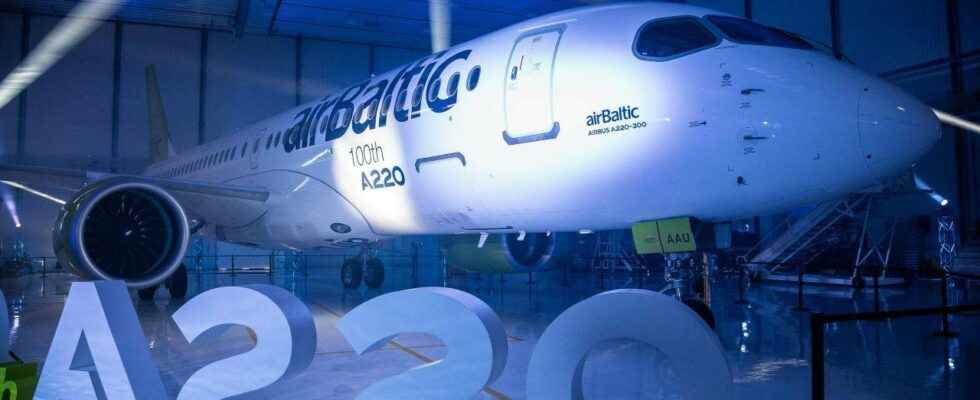(AOF) – Airbus took stock of its commercial activity in 2022. Thus, the aeronautical group delivered 661 commercial aircraft last year to 84 customers. Deliveries are up 8%. Airbus had given up its target of delivering 700 commercial aircraft in 2022 in early December. At the same time, 820 net new orders were recorded. In units, Airbus recorded a net orders-to-delivery ratio significantly above one.
In program detail, the A220 recorded 127 gross new orders while the A320neo Family recorded 888 gross new orders. In the widebody segment, Airbus took 63 gross new orders: 19 A330s and 44 A350s, including 24 A350Fs.
“We are clearly below our targets, but given the complexity of our operating environment, I would like to thank our teams and our partners for the efforts made and the result achieved,” said Guillaume Faury, Executive Chairman of Airbus. . “The considerable order intake recorded for all our families of aircraft, including cargo aircraft, reflects the solidity and competitiveness of our product range. We are continuing to ramp up in order to honor our order book. ”
The annual results for the 2022 financial year will be published on February 16, 2023.
AOF – LEARN MORE
Key points
– Aircraft manufacturer co-world leader with Boeing, born in 1949 under the name Aérospatiale, diversified into satellites;
– Turnover of €52.1 billion, drawn from civil aircraft at 67%, defense & space activities at 21% and helicopters at 12%;
– Order book of €373 billion, 29% from Asia-Pacific, 30% from Europe, 21% from North America, 9% from the Middle East and 5% from Latin America;
– Business model of offering safe and environmentally friendly aeronautical and space solutions, with a strong commitment to society and public services;
– Open capital with strong positions of the French, German (11% each) and Spanish (4%) States, the 9-member Board of Directors being chaired by René Obermann, Guillaume Faury being Managing Director;
– Financial situation supported by public finances with, at the end of September, €8 billion in net cash and free cash flow of €3.5 billion.
Challenges
– “Next chapter” initiative based on 3 pillars -simplification, strengthening and growth- and aiming to create a more profitable, more resilient and leading company in the decarbonization of the industry;
– Innovation strategy integrated into the business model and supported by €2.9 billion in R&D:
– “Fast-Track” roadmap prioritizing electrification, industrial systems, connectivity, autonomy, hardware and artificial intelligence,
– “CRT” organization focused on disruptive technologies, associated with external partnerships,
– structuring: E-Fan Family, ATTOL Fello’Fly, ACIC, TELEO, .ACUBED, BIZ Lab…;
– Environmental strategy with the ambition to become No. 1 in carbon-free aviation:
– design of a “ZEROe” aircraft with hybrid-hydrogen fuel,
– integration into the reporting of emissions emitted by customers,
– launch of 2 hydrogen engine development centers in France and Germany,
– proliferation of initiatives -High5+ reduction of emissions and waste during the production process, Sentinel 5P of air data, Air Race E…
– integration of ESG criteria in certain credit facilities;
– Resumption of hiring and acceleration of the production rate;
– Visibility of the activity with a strong recovery in order intake at the end of September: 647 civil aircraft, 246 helicopters;
– Positive impact of the rise in the dollar, the currency of sale for 80% of revenues;
Challenges
– Russia-Ukraine war: medium-term search for new titanium supply sources and freezing of orders for large air carriers by Aeroflot;
– Supply disruptions: reduction in the number of monthly deliveries of the A 320s;
– Still uncertainties about the future of the SCAF program – air combat of the future;
– Postponement of the entry into service of the A321XLR initially scheduled for early 2024;
– Evolution of legal cases, with the German OHB and with Qatar Airways;
– After a 3.3% increase in operating profit at the end of September, 2022 objectives raised: delivery of 700 civil aircraft, increase in operating profit to €5.5 billion and free cash flow to €4.5 billion.
The end of a duopoly?
For several decades, the American Boeing and the European Airbus have shared 99% of the world market for airliners with more than 110 seats. This market weighs more than 100 billion dollars per year. However, this duopoly seems to be weakened in 2022 for several reasons. First, for the first time, two medium-haul single-aisle aircraft, the Chinese Comac’s C919 and the Russian Irkut’s MC-21, are about to enter service. Added to this is the Boeing 737 MAX crisis. With the cessation of deliveries of this aircraft between 2019 and 2021, the production balance has been broken. In 2021 Boeing posted 340 deliveries, with Airbus remaining well ahead with 611.
